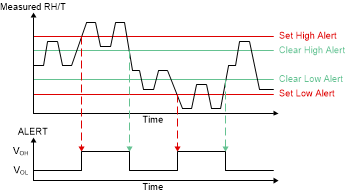JAJSMG0C june 2021 – december 2022 HDC3020 , HDC3021 , HDC3022
PRODUCTION DATA
- 1 特長
- 2 アプリケーション
- 3 概要
- 4 Revision History
- 5 Device Comparison
- 6 Pin Configuration and Functions
- 7 Specifications
-
8 Detailed Description
- 8.1 Overview
- 8.2 Functional Block Diagram
- 8.3
Feature Description
- 8.3.1 Factory Installed Polyimide Tape
- 8.3.2 Factory Installed IP67 Protection Cover
- 8.3.3 Measurement of Relative Humidity and Temperature
- 8.3.4 Offset Error Correction: Accuracy Restoration
- 8.3.5 NIST Traceability of Relative Humidity and Temperature Sensor
- 8.3.6 Measurement Modes: Trigger-On Demand vs Auto Measurement
- 8.3.7 Heater
- 8.3.8 ALERT Output With Programmable Interrupts
- 8.3.9 Checksum Calculation
- 8.3.10 Programmable Offset of Relative Humidity and Temperature Results
- 8.4 Device Functional Modes
- 8.5
Programming
- 8.5.1 I2C Interface
- 8.5.2 I2C Serial Bus Address Configuration
- 8.5.3 I2C Write - Send Device Command
- 8.5.4 I2C Read - Retrieve Single Data Result
- 8.5.5 I2C Read - Retrieve Multi Data Result
- 8.5.6 I2C Repeated START - Send Command and Retrieve Data Results
- 8.5.7
Command Table and Detailed Description
- 8.5.7.1 Reset
- 8.5.7.2 Trigger-On Demand
- 8.5.7.3 Auto Measurement Mode
- 8.5.7.4
ALERT Output Configuration
- 8.5.7.4.1 ALERT Output: Environmental Tracking of Temperature and Relative Humidity
- 8.5.7.4.2 ALERT Output: Representation of Environmental Thresholds and Default Threshold Values
- 8.5.7.4.3 ALERT Output: Steps to Calculate and Program Environmental Thresholds
- 8.5.7.4.4 ALERT Output: Deactivation of Environmental Tracking
- 8.5.7.4.5 ALERT Output: Transfer Thresholds into Non-Volatile Memory
- 8.5.7.5 Programmable Measurement Offset
- 8.5.7.6 Status Register
- 8.5.7.7 Heater: Enable and Disable
- 8.5.7.8 Heater: Configure Level of Heater Current
- 8.5.7.9 Read NIST ID/Serial Number
- 9 Application and Implementation
- 10Device and Documentation Support
- 11Mechanical, Packaging, and Orderable Information
8.5.7.4.1 ALERT Output: Environmental Tracking of Temperature and Relative Humidity
The primary use of the ALERT output is to provide a hardware notification of ambient temperature and relative humidity measurements that violate programmed thresholds. There are a total of four programmable thresholds for temperature and relative humidity, as documented in Table 8-3 and illustrated in Figure 8-25 below.
 Figure 8-25 Graphical Illustration of ALERT Programmable Environmental Thresholds
Figure 8-25 Graphical Illustration of ALERT Programmable Environmental ThresholdsThe four programmable thresholds are listed below
- Set High Alert: Asserts ALERT output when HDC302x measures a temperature or relative humidity level that has risen above this value.
- Clear High Alert: Deasserts the ALERT output caused by Set High Alert, once HDC302x measures a temperature or relative humidity level that has fallen below this value.
- Set Low Alert: Programmed value that asserts ALERT output when HDC302x measures a temperature or relative humidity level that has fallen below this value.
- Clear Low Alert: Programmed value that deasserts the ALERT output caused by Set Low Alert, once HDC302x measures a temperature of relative humidity level that has risen above this value.
If the user application utilizes the ALERT output for environmental tracking, it is best practice to program these four thresholds prior to any temperature or relative humidity measurement acquisition. Programming enough separation between the Set versus Clear thresholds will prevent fast oscillations of the ALERT output.
These programmed limits are accessible at any time of operation .